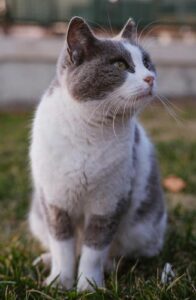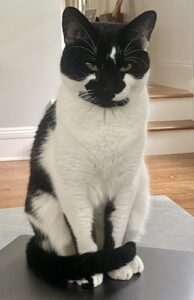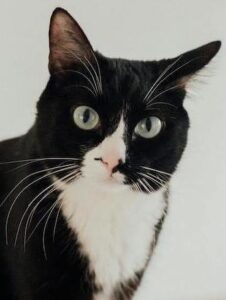 Tuxedo does not refer to a specific cat breed but to a two-color coat pattern. The nature of the color pattern makes it look like the cat is wearing a tuxedo, hence the name. For that reason, most people think of a tuxedo cat as black and white, and it might surprise you to learn that they can also be orange and white, or grey and white. The determining factor is the pattern itself.
Tuxedo does not refer to a specific cat breed but to a two-color coat pattern. The nature of the color pattern makes it look like the cat is wearing a tuxedo, hence the name. For that reason, most people think of a tuxedo cat as black and white, and it might surprise you to learn that they can also be orange and white, or grey and white. The determining factor is the pattern itself.
The typical tuxedo cat has a white chest, a white belly, and one or more white paws, while the rest of the body is black, orange, or gray. A tuxedo cat’s face is also likely to have white markings. They can be domestic cats of almost any breed, so their coats can be short, medium, or long. To develop the pattern, a cat doesn’t need to have two tuxedo parents. If one parent has the tuxedo pattern, that is enough to pass the markings on to their offspring. The tuxedo pattern was long believed to be the result of “slow” or “sluggish” pigment cells that failed to reach all parts of the cat embryo before it was fully formed, leaving white patches in the areas that the pigment cells missed. More recent studies, however, suggest that pigment cells move and multiply randomly during the development of the embryo and that they don’t follow any specific genetic instructions for coat patterns. In either case, the result is a random color distribution, so no two tuxedo patterns will look exactly alike. Additionally, the tuxedo pattern is not associated with any specific gender, unlike the calico or tortoiseshell patterns we see primarily in females. Within the tuxedo category, we have an equal number of males and females.
 The tuxedo cat has an interesting history. Perhaps because the pattern evokes a certain mystery, they have been the subject of several popular myths. Most cat people know that our feline friends were worshiped by the ancient Egyptians, and one myth about the tuxedo cat is that they made up most of the treasured cat population in ancient Egypt. The Egyptians saw cats as demi-deities, who walked the Earth to protect the crops and slow the spread of diseases by killing rodents. Cats were believed to be the physical form of the goddess Bastet. She was the goddess of protection, pleasure, and the bringer of good health. Bastet had the head of a cat and a slender female body, but whether her manifestations on Earth were tuxedos or not remains a mystery. It is a nice story, but we don’t know with scientific certainty if it is true.
The tuxedo cat has an interesting history. Perhaps because the pattern evokes a certain mystery, they have been the subject of several popular myths. Most cat people know that our feline friends were worshiped by the ancient Egyptians, and one myth about the tuxedo cat is that they made up most of the treasured cat population in ancient Egypt. The Egyptians saw cats as demi-deities, who walked the Earth to protect the crops and slow the spread of diseases by killing rodents. Cats were believed to be the physical form of the goddess Bastet. She was the goddess of protection, pleasure, and the bringer of good health. Bastet had the head of a cat and a slender female body, but whether her manifestations on Earth were tuxedos or not remains a mystery. It is a nice story, but we don’t know with scientific certainty if it is true.
A similar myth with roots in ancient beliefs says that the tuxedo cat possesses the ability to become invisible during the time of equinox. An equinox occurs twice a year when the hours of daylight and nighttime are just about equal in length, so this magical feline power is primarily attributed to cats with the black and white tuxedo pattern. They are still regarded by some people today to be magical cats with a special connection to the spirit world.
 Finally, a recent myth about tuxedo cats is that they are allowed free entry into the Metropolitan Opera in New York City, simply because they are always dressed for the occasion. Again, this is an amusing story, but the only animals permitted inside the audience section of the opera are licensed service dogs.
Finally, a recent myth about tuxedo cats is that they are allowed free entry into the Metropolitan Opera in New York City, simply because they are always dressed for the occasion. Again, this is an amusing story, but the only animals permitted inside the audience section of the opera are licensed service dogs.
In addition to the many myths about them, tuxedo cats have claimed a prominent place in popular culture. The cheeky Sylvester from Looney Tunes, Dr. Seuss’ famous character the Cat in the Hat, Figaro from Pinocchio, Felix the Cat, and Mr. Mistoffelees from the Broadway show Cats are all tuxies.




